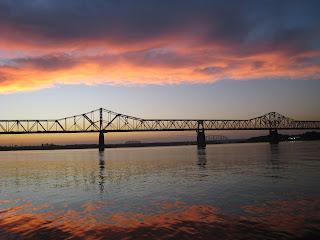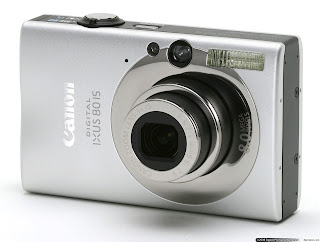I searched the web and my local camera stores for the best replacement, but first I had to figure out what is most important to me for a point and shoot camera.
These things are:
•Speed
•Ease of Use
•Small Size
•Crisp Pictures, both indoor and out
•Video Quality
These qualifications won't fit every user, but as a secondary camera to my D80, and as something that has to fit comfortably in my pocket, these requirements were fitting. Here are a few cameras that I came up with that fit these specifications and would be sufficient to replace my beloved SD800.
Canon PowerShot SD1100 IS
Nikon CoolPix S600
Sony CyberShot DSC-T2
Samsung NV24 HD
Each of these cameras had their advantages, but I ended up with the Canon SD1100 IS because it fit my requirements almost perfectly. Second place was the Nikon S600, but as I will explain, it didn't meet my qualifications as well as the Canon SD1100, not to mention that it is $50 more expensive.
As for the others...
The Sony had the same issues that Sony cameras had when I was purchasing my SD800 IS, namely inaccurate white balance. Sony makes great cameras, and the shots they take are decent for the most part. However, in my experience, the point and shoot cameras lack the brilliant and accurate colors that Canon's are known for. In my brief in store testing with the DSC-T2, the SD1100 outperformed this smaller, lighter camera, offering more consistent, clearer images with more accurate color.
The Samsung turned out to be a one trick pony, although its trick is a very cool one - 720p high definition video recording. I take a surprising amount of video with my digital cameras, and I couldn't get my hands on a demo model, but other reviewers have commented on its lack of consistent image quality while taking regular photos as well as lack of speed. Both of these drawbacks held this from being my camera of choice as well.
But now onto the top two, and why I ended up with the Canon over the higher spec'd Nikon.
First,
 the SD1100 is quick. When a friend is laughing hysterically with blue icing all over his teeth, I want to be able to pull my camera out and capture the moment quickly and clearly, so speed is a necessity. A quick stopwatch timing shows that the camera takes a bit over a second and a half from completely off to taking a picture with no flash. The SD1100 also manages to keep up between shots, taking less than a second between each to snap a second, third, fourth, fifth, and sixth picture, all within five seconds of the initial shot. The Nikon competitor advertises that it's "stunningly fast," and it's definitely quicker than most cameras I've used at about one frame per second continuous shooting. However, the Canon struck me as quicker from the start and boasts a slightly quicker 1.3 fps spec.
the SD1100 is quick. When a friend is laughing hysterically with blue icing all over his teeth, I want to be able to pull my camera out and capture the moment quickly and clearly, so speed is a necessity. A quick stopwatch timing shows that the camera takes a bit over a second and a half from completely off to taking a picture with no flash. The SD1100 also manages to keep up between shots, taking less than a second between each to snap a second, third, fourth, fifth, and sixth picture, all within five seconds of the initial shot. The Nikon competitor advertises that it's "stunningly fast," and it's definitely quicker than most cameras I've used at about one frame per second continuous shooting. However, the Canon struck me as quicker from the start and boasts a slightly quicker 1.3 fps spec.The ease of use was also a huge detractor from the Nikon where the Canon excelled. Granted, ease of use is a subjective judgement and I've owned and used a Canon almost exclusively for almost two years, but my first two cameras were Nikon point and shoots, so, in theory, both should be equally intuitive for me. Canon seems to have further refined their user interface into a smooth and logical way to operate the camera whereas the Nikon seemed to be more complicated and more difficult to figure out. For example, switching the camera from shooting mode to video mode is a simple slider on the back of the Canon, where the nikon requires going into the modes menu, rotating the selection ring, settling on the video shooting mode, and then pressing okay. Overall, the Canon seemed much more logical in its button layout and was simpler to use.
The Canon and Nikon are within .2 in all dimensions and weight, so for all logical comparisons, the two are the same size. Both are smaller than the SD800 IS and felt about the same in my pocket. The Nikon was .2 oz heavier, but that's a miniscule difference and wasn't enough to make a decision based on weight alone.
Here's a comparison of the Canon (purple) and Nikon (black) against a pack of playing cards:

Canons are best known for their abilities to capture amazing color and crisp lines in outdoor shots. The shot below, for example, was taken with my SD800 IS. My experience with prior Nikons was that they took fine pictures, but just lacked the definition that the Canons had. I read many reviews of both cameras to find any caveats that I may have missed during my testing. There were a few reviewers who noted that the Nikon took great pictures, but that they were "soft," where the Canon produced much more vivid images.
Both cameras pack optical image stabilization/vibration reduction which help with motion blur and shaky hands, but considering the Nikon takes soft images even in near perfect conditions, the Canon was definitely the winner here as well.


As  for video quality, both the Canon and the Nikon have the same video resolution and both utilize the optical image stabilization during recording. Neither camera was able to use optical zoom during video recording, but the digital zoom on the Canon was a smooth zoom whereas the Nikon had a choppy, incremental digital zoom. The audio on both seemed about the same as well, so the cameras tied this category.
for video quality, both the Canon and the Nikon have the same video resolution and both utilize the optical image stabilization during recording. Neither camera was able to use optical zoom during video recording, but the digital zoom on the Canon was a smooth zoom whereas the Nikon had a choppy, incremental digital zoom. The audio on both seemed about the same as well, so the cameras tied this category.
 for video quality, both the Canon and the Nikon have the same video resolution and both utilize the optical image stabilization during recording. Neither camera was able to use optical zoom during video recording, but the digital zoom on the Canon was a smooth zoom whereas the Nikon had a choppy, incremental digital zoom. The audio on both seemed about the same as well, so the cameras tied this category.
for video quality, both the Canon and the Nikon have the same video resolution and both utilize the optical image stabilization during recording. Neither camera was able to use optical zoom during video recording, but the digital zoom on the Canon was a smooth zoom whereas the Nikon had a choppy, incremental digital zoom. The audio on both seemed about the same as well, so the cameras tied this category.Now, 
while the Canon won all of these comparisons, all while maintaining a $50 less expensive price point, you do get a few worthwile things for your money with the Nikon. First is a superior zoom, which is both wider angle and longer telephoto than the Canon's. This means that you can be closer to your subject and further zoomed out, or further from you subject and zoomed in closer than the Canon would be able to. The second thing is a marginally larger screen at .2" bigger, and while that may not seem like a huge amount, when it's 2.5" vs 2.7", there is a definite advantage to the larger screen. The Canon's superior user interface and vivid colors won me over, but Nikon has really improved their consumer cameras and I feel that the S600 would make for an extremely fine camera for a user that desired these features.

while the Canon won all of these comparisons, all while maintaining a $50 less expensive price point, you do get a few worthwile things for your money with the Nikon. First is a superior zoom, which is both wider angle and longer telephoto than the Canon's. This means that you can be closer to your subject and further zoomed out, or further from you subject and zoomed in closer than the Canon would be able to. The second thing is a marginally larger screen at .2" bigger, and while that may not seem like a huge amount, when it's 2.5" vs 2.7", there is a definite advantage to the larger screen. The Canon's superior user interface and vivid colors won me over, but Nikon has really improved their consumer cameras and I feel that the S600 would make for an extremely fine camera for a user that desired these features.
What digital camera are you using, and what do you like/dislike about it most? Post in the comments!


No comments:
Post a Comment